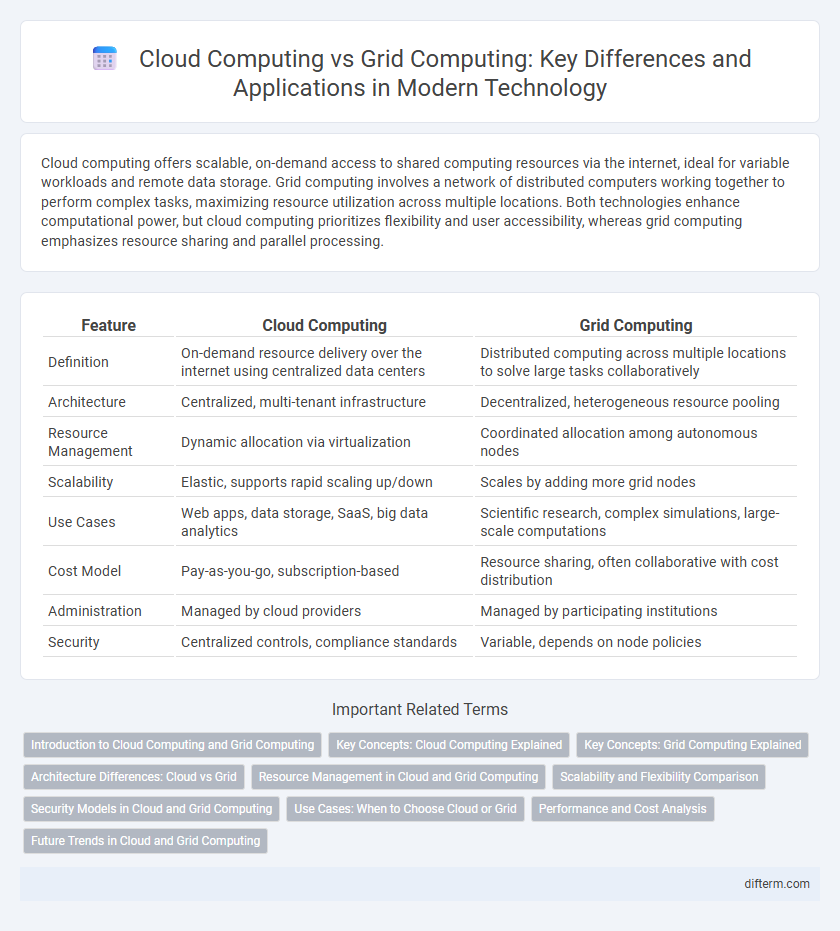Cloud computing offers scalable, on-demand access to shared computing resources via the internet, ideal for variable workloads and remote data storage. Grid computing involves a network of distributed computers working together to perform complex tasks, maximizing resource utilization across multiple locations. Both technologies enhance computational power, but cloud computing prioritizes flexibility and user accessibility, whereas grid computing emphasizes resource sharing and parallel processing.
Table of Comparison
| Feature | Cloud Computing | Grid Computing |
|---|---|---|
| Definition | On-demand resource delivery over the internet using centralized data centers | Distributed computing across multiple locations to solve large tasks collaboratively |
| Architecture | Centralized, multi-tenant infrastructure | Decentralized, heterogeneous resource pooling |
| Resource Management | Dynamic allocation via virtualization | Coordinated allocation among autonomous nodes |
| Scalability | Elastic, supports rapid scaling up/down | Scales by adding more grid nodes |
| Use Cases | Web apps, data storage, SaaS, big data analytics | Scientific research, complex simulations, large-scale computations |
| Cost Model | Pay-as-you-go, subscription-based | Resource sharing, often collaborative with cost distribution |
| Administration | Managed by cloud providers | Managed by participating institutions |
| Security | Centralized controls, compliance standards | Variable, depends on node policies |
Introduction to Cloud Computing and Grid Computing
Cloud computing delivers on-demand computing resources via the internet, enabling flexible scalability, remote data storage, and broad accessibility for businesses and individuals. Grid computing distributes computational tasks across multiple networked computers, harnessing their combined processing power to solve complex problems more efficiently. Both paradigms optimize resource utilization but differ in architecture and application scope, with cloud computing emphasizing service models and grid computing focusing on collaborative processing.
Key Concepts: Cloud Computing Explained
Cloud computing delivers on-demand access to scalable computing resources via the internet, enabling flexible storage, processing power, and application deployment without needing physical hardware. It leverages virtualization and multi-tenant architecture to maximize resource utilization and facilitate rapid provisioning. Cloud providers offer services such as Infrastructure as a Service (IaaS), Platform as a Service (PaaS), and Software as a Service (SaaS), which streamline development and operational efficiency.
Key Concepts: Grid Computing Explained
Grid computing involves a distributed architecture where multiple computer resources are connected to achieve a common goal by sharing processing power and data storage across a decentralized network. Unlike cloud computing, which relies on centralized data centers providing on-demand services, grid computing dynamically harnesses geographically dispersed resources to solve complex computational problems. Key concepts include resource virtualization, workload distribution, and task parallelization, enabling efficient collaboration between autonomous systems to maximize performance and scalability.
Architecture Differences: Cloud vs Grid
Cloud computing architecture centers around service-oriented models with virtualized resources managed through centralized data centers, enabling on-demand scalability and flexible resource allocation. Grid computing architecture relies on a distributed network of heterogeneous and loosely coupled resources, coordinated through middleware to perform large-scale parallel processing tasks. The fundamental difference lies in cloud's abstraction of infrastructure as a service versus grid's emphasis on resource sharing across multiple administrative domains.
Resource Management in Cloud and Grid Computing
Cloud computing employs centralized resource management through virtualized environments, enabling dynamic allocation of computing power, storage, and network resources on demand. Grid computing utilizes decentralized resource management across multiple distributed systems, coordinating heterogeneous resources to collectively execute complex tasks. Efficient resource scheduling, load balancing, and fault tolerance are critical mechanisms distinguishing resource management strategies between cloud and grid computing architectures.
Scalability and Flexibility Comparison
Cloud computing offers superior scalability by providing on-demand resource allocation and automatic load balancing across virtualized infrastructure, enabling seamless handling of fluctuating workloads. Grid computing relies on a distributed network of heterogeneous resources, which can limit flexibility due to dependency on resource availability and manual configuration. Flexibility in cloud computing is enhanced through centralized management and elastic scaling, whereas grid computing requires complex coordination to adapt dynamically to changing computational demands.
Security Models in Cloud and Grid Computing
Cloud computing security models emphasize data encryption, identity management, and multi-tenant isolation to protect against unauthorized access and ensure compliance with regulatory standards. Grid computing security relies heavily on authentication, authorization, and secure resource sharing through protocols like Public Key Infrastructure (PKI) and Virtual Organization Membership Service (VOMS). Both models implement robust security mechanisms tailored to their architectures, with cloud focusing on centralized security controls and grid enabling decentralized trust management.
Use Cases: When to Choose Cloud or Grid
Cloud computing excels in use cases requiring scalable, on-demand resources such as web hosting, SaaS deployment, and big data analytics, where flexible resource allocation and pay-as-you-go pricing optimize cost and performance. Grid computing is ideal for complex scientific simulations, large-scale mathematical computations, or projects demanding high-performance, distributed processing across multiple administrative domains. Choosing cloud computing suits dynamic workloads with variable demand, while grid computing fits static or batch processing workloads with consistent, resource-intensive computation needs.
Performance and Cost Analysis
Cloud computing offers scalable resources with pay-as-you-go pricing, reducing upfront costs and optimizing operational expenses for varying workloads. Grid computing leverages distributed computing power across multiple locations, often resulting in cost savings for large-scale, batch-processing tasks but may incur higher management complexity. Performance-wise, cloud platforms provide on-demand, elastic resources with consistent low latency, whereas grid computing depends on network heterogeneity and may experience variable performance due to resource decentralization.
Future Trends in Cloud and Grid Computing
Emerging trends in cloud computing emphasize serverless architectures, edge computing integration, and AI-driven automation to enhance scalability and reduce latency. Grid computing is evolving with blockchain-based resource sharing and decentralized data processing to improve security and fault tolerance. Both paradigms are converging towards hybrid models that leverage distributed resources for optimized performance and cost-efficiency in complex computational tasks.
cloud computing vs grid computing Infographic

 difterm.com
difterm.com